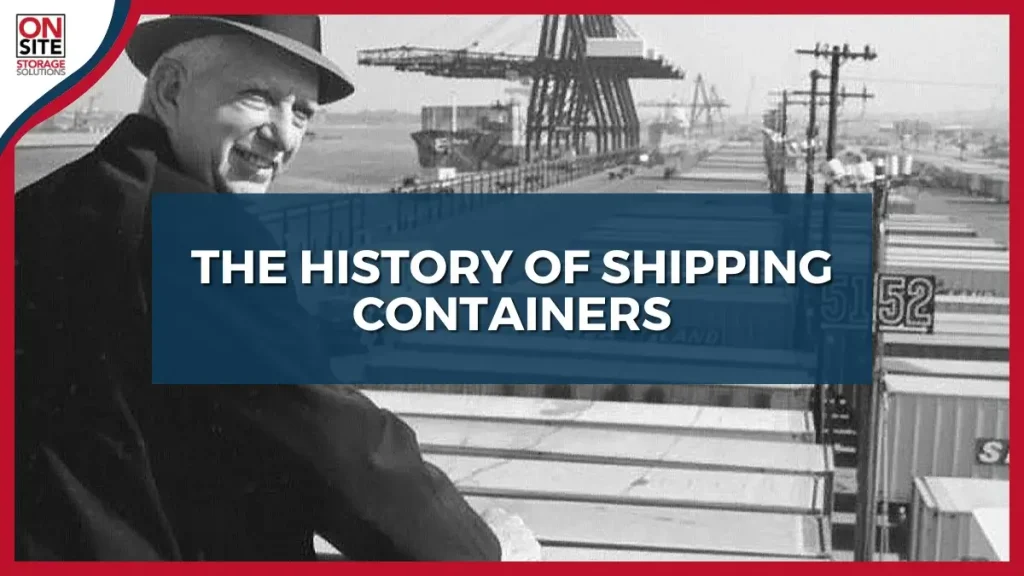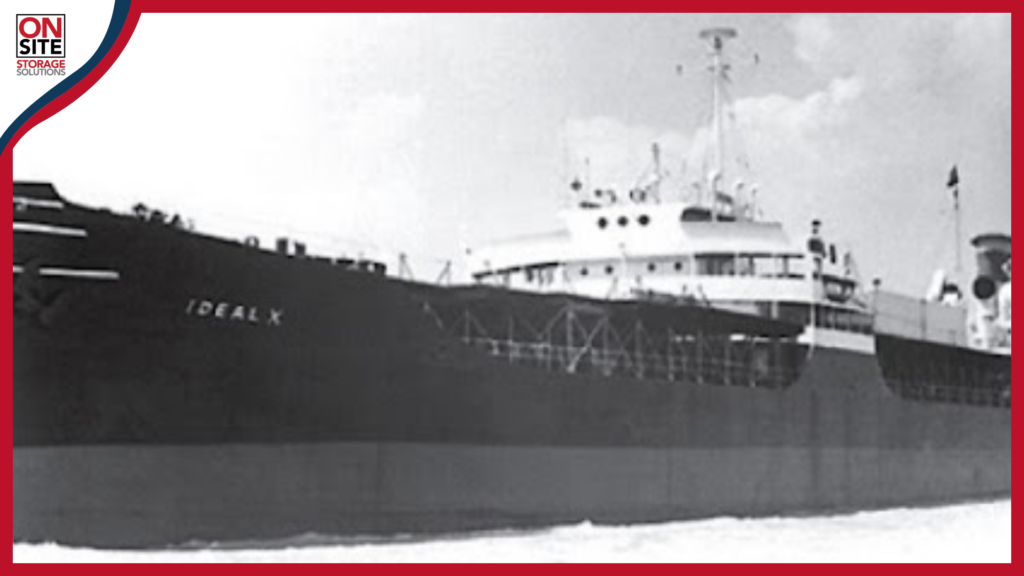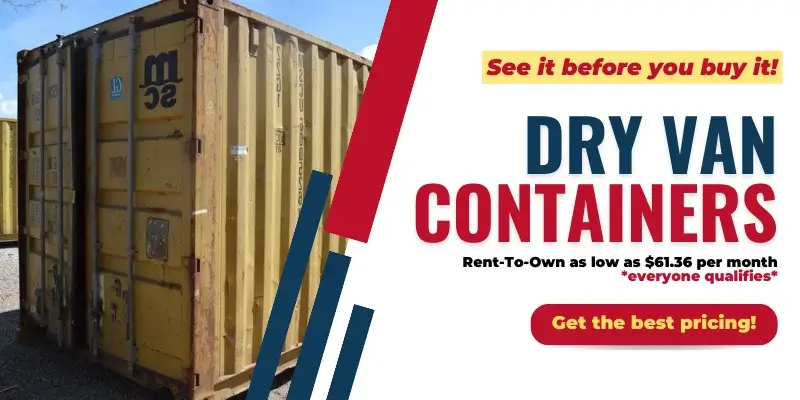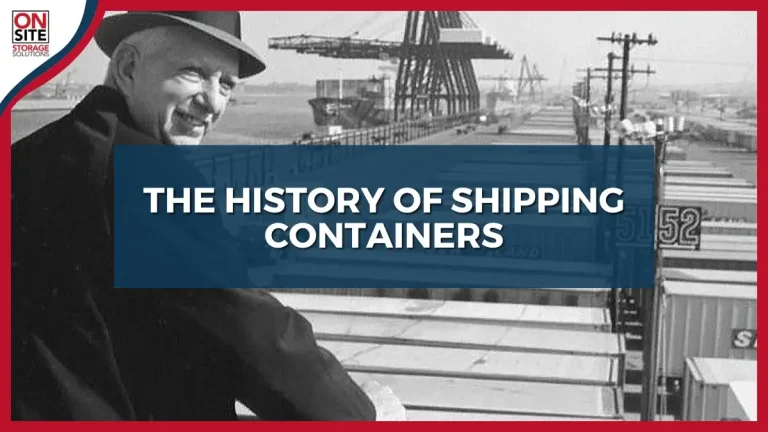
Ever wondered how the shipping container became the marvel of engineering and logistics that it is today? From its invention to its modern-day use in global economies, shipping containers have gone through a long and winding history. Here, you can find an overview of the journey taken by these remarkable containers.
Table of Contents:
- The World Before Shipping Containers
- The Origins of the Shipping Container
- Who is Malcolm McLean?
- Intermodal Transport
- The Standardization of Containers
- Resistance Against The Spread Of Container Shipping
- The Modern Shipping Container
- On-Site Storage Solutions
The World Before Shipping Containers
Before the creation of shipping containers, people would have to load and unload cargo by hand. For centuries, people have been sailing across oceans to bring back new items such as food, cotton, treasure, and other things that their country has never seen before. This was a time-consuming and labor-intensive process, prone to damages and accidents. In addition, there was no standardized way of packaging or storing goods, which made it difficult to keep track of inventory. To put this into perspective, think about the Egyptians, Greeks, Romans, and more recently the British! How did they transport their goods around the world? They clearly shipped to other countries, but without any standardization, it was a slow and challenging process.
Once merchandise arrived at the port, it would sit in a warehouse until space opened up on a vessel. Then, laborers would move the products from storage and load them onto the ship. In the past, people would pack merchandise into sacks, bales, crates or barrels before hand-loading them onto the vessel.
Can you imagine how much work this was? This process was called breakbulk cargo. Each ship held around 200,000 pieces of cargo, quickly becoming a problem as the second industrial revolution progressed (the early 1900s) and trains became more popular. Shipping cargo via ship was much slower than other methods and often resulted in delays at the ports. For example, large ships could take up to a week to unload and reload. This was the only way to transport goods for centuries until recent advancements changed the process.
(Levinson, 2006: The Box: How the Shipping Container Made the World Smaller and the World Economy Bigger).
The Origins of the Shipping Container
The first shipping container was designed by American trucking magnate Malcolm McLean in 1956. McLean recognized the potential for using standardized containers to transport cargo more efficiently. He had the idea of using large metal boxes that could be loaded onto ships, trucks, and trains using cranes.
Who Is Malcolm McLean?
Born in 1914, Malcolm McLean grew up on a farm in North Carolina. In 1931, he completed school and worked for years to save money to buy a used truck; which he did in 1934 when he started his transport business. By 1941, he had successfully scaled up his transport business by adding five trucks under him. During a routine delivery of cotton bales in 1937, from North Carolina to New Jersey, McLean witnessed dockworkers loading and unloading cargo, which took hours upon hours. He contemplated what a waste of time and money this was.
For thirteen years, from 1937 until 1950, McLean’s primary focus was on his truck transportation business. In fact, by the time he started focusing on other projects again in 1950, his company had grown to include 1,750 trucks and 37 transport terminals–making it the fifth-largest trucking company in America. During this time, McLean’s drivers were often fined for transporting heavy loads of cargo due to several weight restrictions and levying fees placed on road transportation. After processing how he could transport his clients’ items more effectively, McLean was reminded of an event from 1937. He had the idea to create a uniformed-sized trailer that could be loaded onto boats by the hundreds rather than one or two at a time like with his trucks. By removing the majority of his trucks and replacing them with boats, he knew he could change his transportation business for the better. This would allow trucks to only be used for shorter deliveries within one state, which in turn would get rid of new weight restrictions and levying fees.
Intermodal Transport
In 1955, McLean sold his trucking business after being convinced by an idea to create a standardized shipping trailer or container. With the $42 million he made from the sale, he took out a bank loan and used $7 million of it to purchase Pan-Atlantic Steamship Company. Many of the port cities that McLean wanted to dock in were already under Pan-Atlantic’s jurisdiction. After buying them out, he renamed the company SeaLand Industries.

After working with engineer Keith Tantlinger to design and test various shipping container prototypes, McLean finally landed on a less advanced version of today’s containers. His were strong, standardized, stackable, easy to load and unload, and lockable – making them theft-resistant. With the containers in hand, all that was left for McLean to do was design ships that could support them. He purchased a converted WWII tanker ship, Ideal X, and outfitted it to hold 58 of his newly designed containers on top of 15,000 tons of petroleum. This was the first time that shipping containers were used to transport cargo across the ocean.

The First Container ship, Ideal X: a converted WWII tanker ship
The success of the design was evident when orders started flooding in from Houston even before the ship carrying the product docked back in New Jersey. McLean offered a 25% discount on the price of conventional cargo transportation, which was the main reason for its success. In addition, because the containers were lockable, they prevented theft during transit.
After Ideal X’s successful first trip, McLean ordered the very first ship designed to transport containers: Gateway City.
Gateway City’s maiden voyage was in October 1957 and it traveled from New Jersey to Miami. Even more impressive, two groups of dockworkers were able to unload and load the cargo at an unbelievable rate of 30 tons per hour – unheard of for that time period.
The Standardization of Containers
At this point, McLean was using 35-foot containers, different from the 20 and 40-foot containers which we see today. Although there was a lack of standardization for container sizes and corner fittings, containers needed to be uniform so they could be stacked efficiently. Also, transport equipment like trains, trucks, etc., required that all containers were built to one size so each method of transportation could use the same sized container.

The US government during the Vietnam War was searching for a more productive shipping method and proposed standardization. However, McLean’s SeaLand Industries continued to use 35-foot containers while Matson’s only used 24-foot containers. McLean agreed to release his patent for the shipping container corner posts, which are essential to its strength and stacking ability. In doing so, several standards were agreed upon:

Consequently, we have 20-foot and 40-foot shipping containers, along with a few other less familiar sizes. In truth, 20-foot containers, or Twenty-foot Equivalent Units (TEUs), went on to become the industry norm for referencing cargo size.
Resistance Against The Spread Of Container Shipping
Though containerized shipment contributes many advantages, not everyone agreed with it, and efforts were made to impede its global growth. In the past, loading cargo needed lots of port workers who would physically move all the goods into place. The use of containers caused an uproar among dockside unions, as it obviated the need for their workers. In response, union workers went on strike in the early 1970s, disrupting shipping and hindering the expansion of containerization. Although union workers were initially hesitant of containerized shipping, the severance packages assuaged their fears and growth continued unabated.
The Modern Shipping Container
The modern shipping container is a standardized steel box that can be easily loaded and unloaded using cranes. These containers are typically 20 or 40 feet long, 8 feet wide, and 8 feet tall. They are designed to be stackable and intermodal, meaning they can be transported by ship, truck, or train. Today, shipping containers are a vital part of the global economy, transporting millions of tons of cargo every year. They have transformed the way we move goods around the world, and have made international trade easier and more efficient than ever before.
The container shipping industry has come a long way since its humble beginnings, and it shows no signs of slowing down. Thanks to the hard work of those in the industry, we can now enjoy the many benefits of containerized shipping.
On-Site Storage Solutions
If you’re interested in acquiring or renting shipping containers of various sizes, please don’t hesitate to contact us. We offer a variety of shipping containers that are perfect for businesses and homes alike. Our team members will be more than happy to answer any questions you may have about our services. We hope this article was informative and helped you understand the role shipping containers play in today’s economy.
FREQUENTLY ASKED QUESTIONS
The shipping container was invented by American entrepreneur Malcom McLean in 1956. His invention revolutionized shipping and global trade by introducing a standardized and transportable storage vessel. McLean’s innovation led to increased efficiency, reduced costs, and facilitated the growth of global commerce.
In 1956, American entrepreneur Malcolm McLean invented the standard cargo container, revolutionizing global transport and trade. These shipping containers, which are still prevalent today, introduced an efficient and standardized approach to shipping goods internationally.
Shipping containers were standardized in 1968 by the International Standards Organization. This standardization made it easier for shipping companies to transport goods globally.












